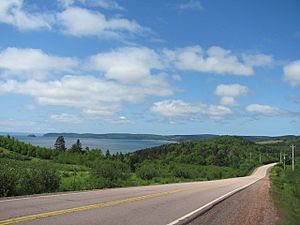Cumberland County, Nova Scotia facts for kids
Quick facts for kids
Cumberland County
|
|||
|---|---|---|---|
|
County
|
|||
|
|||

Location of Cumberland County, Nova Scotia
|
|||
| Country | Canada | ||
| Province | Nova Scotia | ||
| Towns | Amherst / Oxford | ||
| Established | August 17, 1759 | ||
| Incorporated | April 17, 1879 | ||
| Electoral Districts Federal |
Cumberland—Colchester |
||
| Provincial | Cumberland North / Cumberland South | ||
| Government | |||
| • Type | Cumberland County Municipal Council | ||
| Area | |||
| • Land | 4,275.77 km2 (1,650.88 sq mi) | ||
| Population
(2021)
|
|||
| • Total | 30,538 | ||
| • Density | 7.1/km2 (18/sq mi) | ||
| • Change 2011-16 | |||
| Time zone | UTC-4 (AST) | ||
| • Summer (DST) | UTC-3 (ADT) | ||
| Area code(s) | 902 | ||
| Dwellings | 18,445 | ||
| Median Income* | $38,433 CAD | ||
| Website | www.cumberland county.ns.ca | ||
|
|||
Cumberland County is a county in the Canadian province of Nova Scotia.
Cumberland County was named in 1755 in honor of the Duke of Cumberland. The county was founded in 1759 and was later divided in 1840. The area thrived in the 19th century with the development of lumbering, shipbuilding, and coal mining, but rural outmigration and deforestation led to some communities being abandoned in the 20th century. The county spans an area of 4,271.23 km2, with resources including extensive forest land, several mineral resources, and agricultural areas that concentrate on wild blueberry harvesting. As of the 2021 census, Cumberland County had a population of 30,538, with the majority residing in the Municipality of the County of Cumberland. The county includes two towns, Amherst and Oxford, and two large population centers, Parrsboro and Springhill.
Contents
History
The name Cumberland was applied by Lieutenant-Colonel Robert Monckton to the captured Fort Beauséjour on June 18, 1755 in honour of the third son of King George II, William Augustus, Duke of Cumberland, victor at Culloden in 1746 and Commander in Chief of the British forces. The Mi'kmaq name for the area was "Kwesomalegek" meaning "hardwood point".
Cumberland County was founded on August 17, 1759. When the Township of Parrsboro was divided in 1840, one part was annexed to Cumberland County and the other part annexed to Colchester.
The dividing line between Cumberland and Colchester was established in 1840. In 1897, a portion of the boundary line between the Counties of Colchester and Cumberland was fixed and defined. The county thrived in the 19th century with the development of lumbering, shipbuilding and coal mining. Deforestation and rural outmigration in the 20th century led to the abandonment of some communities such as Eatonville and New Yarmouth.
Geography
The county has a total area of 4,271.23 km2 (1,649.13 sq mi).
Cumberland County is rich in natural resources with extensive forest land supporting lumber mills and pulp contractors. It has many mineral resources, including 2 operating salt mines. Until the 1970s it also had several coal mines which extracted coal from seams that run from Joggins to River Hebert and on to Athol and Springhill.
Agriculture is concentrated on wild blueberry harvesting throughout the Cobequid Hills, as well as mixed farms located in the Tantramar Marshes region, the Northumberland Strait coastal plain, and the Wentworth Valley.
The northwestern edge of Cumberland County forms part of the Isthmus of Chignecto, the natural land bridge connecting the Nova Scotia peninsula to North America. As such, the county hosts several important transportation corridors, including Highway 104 (the Trans-Canada Highway) and CN Rail's Halifax-Montreal railway line. The county line bordering New Brunswick is around 30 kilometres long (18.5 miles).
Two towns are located in Cumberland County: Amherst and Oxford. Parrsboro and Springhill both have populations exceeding 1000 people, but lack their own town governments.
Demographics
As a census division in the 2021 Census of Population conducted by Statistics Canada, Cumberland County had a population of 30,538 living in 14,139 of its 18,363 total private dwellings, a change of 1.8% from its 2016 population of 30,005. With a land area of 4,275.77 km2 (1,650.88 sq mi), it had a population density of 7.1/km2 (18/sq mi) in 2021.
Forming the majority of the Cumberland County census division, the Municipality of the County of Cumberland, including its Subdivisions A, B, C, and D, had a population of 19,964 living in 9,126 of its 12,988 total private dwellings, a change of 2.9% from its 2016 population of 19,402. With a land area of 4,253.04 km2 (1,642.11 sq mi), it had a population density of 4.7/km2 (12/sq mi) in 2021.
|
Population trend
|
Mother tongue language (2011)
|
Ethnic Groups (2006)
|
Communities
- Towns
- Villages
- County municipality and county subdivisions
- Municipality of the County of Cumberland
- Cumberland Subdivision A
- Cumberland Subdivision B
- Cumberland Subdivision C
- Cumberland Subdivision D
Highways
 Trunk 2
Trunk 2 Trunk 4
Trunk 4 Trunk 6
Trunk 6 Hwy 104 (TCH)
Hwy 104 (TCH) Hwy 142
Hwy 142 Route 204
Route 204 Route 209
Route 209 Route 321
Route 321
See also
- List of municipalities in Nova Scotia
- Central Nova Tourist Association — Tourism Association Representing Cumberland County.
- Royal eponyms in Canada
- Black Lake listings within Nova Scotia.




